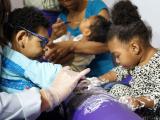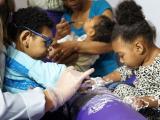Though Zika outbreak developments have tailed off in recent months, research activity to better understand the risk and spread continues at a brisk pace, with a research team from New York today reporting on baseline microcephaly findings and other groups reporting on the virus in breast milk and in oropharyngeal secretions.
Microcephaly baseline findings
One of the challenges in assessing the link between Zika and microcephaly has been a lack of good information on background estimates for the birth defect. Researchers from New York and the US Centers for Disease Control and Prevention (CDC) recently calculated the background level for that state, using data from 2013 to 2015 before imported cases began to appear in the United States. They reported their findings in the latest issue of Morbidity and Mortality Weekly Report (MMWR).
Two surveillance sources identified a total of 529 suspected microcephaly cases in New York from 2013 to 2015, of which 499 met the case definition. The state's overall prevalence was 7.4 per 10,000 live births, similar to national estimates for 2009 to 2013. For severe microcephaly, the prevalence was 4.2 per 10,000 live births.
A substantial number (42%) didn't have any known maternal or fetal risk factors. When the team looked at severe microcephaly cases, they found that a higher proportion of affected infants were born to Hispanic and non-Hispanic black mothers, which they said needs more investigation about risk factors and disparities.
They concluded that the New York prevalence estimates for severe microcephaly will help researchers more clearly estimate the risk of Zika virus.
Case reports shed light on Zika in breast milk
Scientists have been trying to gauge the risk of human-to-human Zika spread through different body fluids, and a case study of four Zika-infected mothers from Brazil suggests that transmission to babies through breast milk may not be an efficient route. Researchers published their findings in an early advance edition of the International Journal of Infectious Diseases.
Despite evidence Zika in the mothers' blood and urine samples, along with the presence of viral shedding, no illnesses developed in three of the breastfed babies, though one had a fever and rash that were linked to a chikungunya infection.
One breast milk sample from one of the mothers yielded infectious virus.
The team said Zika transmission by breast milk is still questionable, and it might be less efficient than human-to-human transmission by other body fluids.
Saliva spread real but risk appears low
Zika can be transmitted through the oropharyngeal mucosa, but the risk appears to be low, based on experiments with macaques by researchers from the University of Wisconsin. They reported their findings yesterday in bioRxiv, a prepublication Web portal for scientific studies.
Application of high doses of Zika virus to the tonsils of three macaques resulted in a positive blood tests by 2 days after exposure, similar to earlier findings on subcutaneous exposure.
Three more monkeys were infected by the subcutaneous route to serve as saliva donors to allow testing of exposure to oral secretions by different routes: conjunctival, tonsils, and nostrils. Seven animals repeatedly exposed to the saliva from the Zika-infected macaques did not become infected.
Researchers concluded that though there is a risk of infection by the mucosal route, the risk of exposure from people with typical infections is low.
See also:
Feb 9 MMWR report
Feb 7 Int J Infect Dis abstract
Feb 8 bioRxiv abstract























